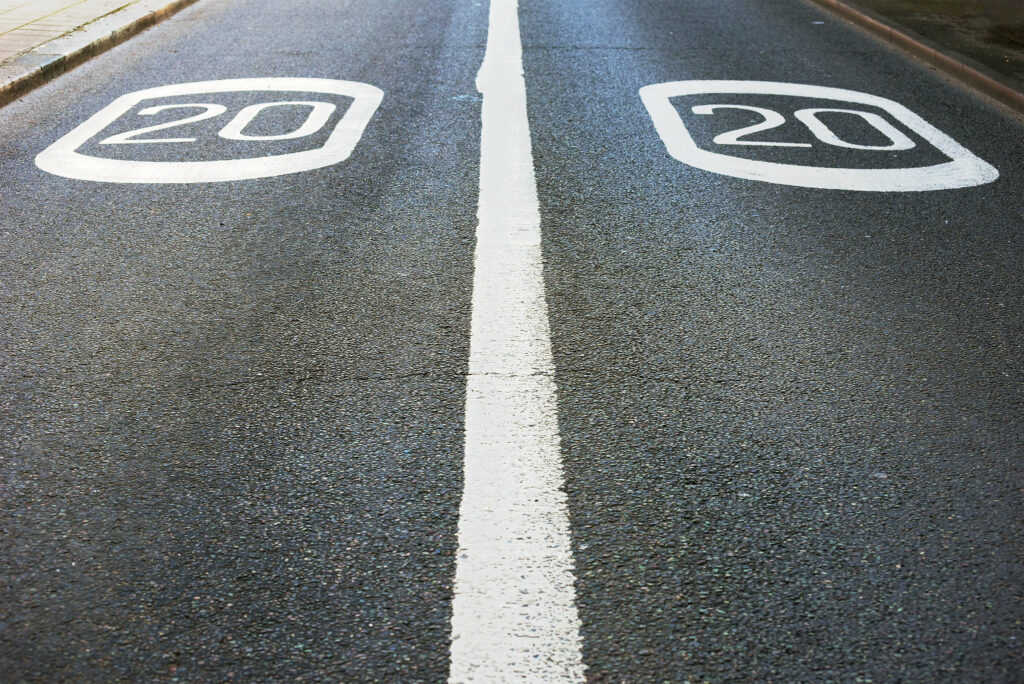Twenty is Plenty didn’t slow drivers down. It wasn’t supposed to.

Friday, March 11, 2022
Boulder’s 20 is Plenty push — in which speed limits were lowered citywide from 25 to 20 mph on neighborhood streets — didn’t actually slow drivers down, a staff analysis has found.
In fact, 5.88% fewer people drove under 20 miles per hour after new speed limit signs were installed, and roughly 2% more cars travelled over 30 or 35 mph at 22 locations, according to the city’s own data.
“Overall,” staff wrote in notes to city council for Tuesday’s meeting, “vehicle speeds on local streets did not measurably change after implementing 20 is Plenty.”
Still, leaders are standing behind the decision, arguing that lower speed limits are just the first step toward creating a culture of safer driving in Boulder.
“It’s still a call to action that we want people to recognize the need to drive slow in neighborhoods,” said Principal Traffic Engineer Devin Joslin. “We want to make it clear is that the expectation is that people drive slowly within neighborhoods.”
Limits just one layer
The slight changes in speed aren’t significant, Joslin said. Firstly, the speed-measuring device has a 1 mph margin of error. And data collection was more limited than what staff would have liked; elected officials rejected a recommended $100,000 pilot project and study in lieu of immediate citywide implementation.
Results were in line with efforts elsewhere. Portland, Oregon, also found no real change in driving speed after lowering its speed limits from 25 to 20 mph. Seattle had a bit more success when it dropped speeds on larger roadways from 30 to 25. Even so, both cities — plus interviews with experts in Eugene, Oregon, and Cambridge, Massachusetts — “found that implementing lower speed limits revealed a need to retrofit streets with traffic calming to reinforce the lower speed limits.”
“The best way to change driver behavior is to change infrastructure,” said Alex Weinheimer, a transportation professional and member of Boulder’s Transportation Advisory Board.
Narrower streets, roads without a painted centerline, a mature tree canopy, cars parked parallel along the side of the street — all these elements “provide a little more focused visual for the driver,” Joslin said. Such design changes will be pursued in the future as a followup to lower speed limits.
Read: It’s a hump. It’s a bump. It’s a speed kidney. Boulder Beat
Said Joslin, “Sometimes it takes the layering of many interventions.”
The four peer cities staff studied as part of 20 is Plenty design streets based on desired speeds rather than the old standard of 85th percentile speeds — that is, the speed 85% of drivers will travel at or below. Boulder intends to follow suit, one reason Joslin believes the effort was worth it.
“We learned a lot in doing that evaluation that will let us look more critically at how we set speed limits in the city,” not just in neighborhoods but on bigger streets, he said. “It certainly was not all for nought.”
Minimal cost, maximum safety
Lowering residential speed limits was part of the city’s Vision Zero goals to eliminate serious injury or death from traffic crashes in Boulder. 150 people were seriously injured and nine killed in 151 severe crashes throughout the city from 2018-2020, despite a huge decline in driving during the COVID-19 pandemic. According to a recently updated Safe Streets report, 17 of those crashes were on neighborhood streets.
The move was not without its critics. Community members peppered city council with angry emails about the cost of switching out speed limit signs to special ones that include Vision Zero messaging. It cost $65,000 to replace more than 450 signs, paid for from a one-time bump to the transportation budget in 2020.
Elected officials at the time were unmoved, voting unanimously to implement the speed limit change. Council members noted the low cost — just 0.15% of overall transportation spending, and less than 5% of what the city spends on snow removal each year — and exponential safety gains from lower speeds.
Ninety percent of pedestrians survive being hit by cars traveling at 20 miles per hour. At 30 mph, that drops to 50%.
“Worst case,” councilman Aaron Brockett said at the time, “is that speeds don’t change a lot.”
Attitudes don’t appear to have changed much now that the data is in. Council asked exactly one question about 20 is Plenty during Tuesday’s discussion (Will it ever lower speed limits? To which the answer was: Maybe, but not without other changes.) and offered little feedback other than praise of the detailed data.
In perhaps the only nod to the limited short-term effectiveness of the initiative, now-Mayor Brockett said, “Everything keeps us directing us toward making our core arterial network safer. That’s where the injuries happen.”
Transportation leaders still believe 20 is Plenty was worth it — or will be, eventually.
“(We) viewed this as a low-risk endeavor,” said TAB’s Weinheimer. “We thought it would kick off this change in culture.”
At the end of the day, Joslin said, all that’s being asked of people is that they drive a little more slowly in the places where they and their neighbors live.
“If you drive a mile at 25 and drive a mile at 20, you get there 10 seconds faster,” he said. “Can you spare 10 seconds to save a life?”
— Shay Castle, @shayshinecastle
Want more stories like this, delivered straight to your inbox? Sign up for a weekly newsletter from Boulder Beat.
Help make the Beat better. Was there a perspective we missed, or facts we didn’t consider? Email your thoughts to boulderbeatnews@gmail.com
Transportation Aaron Brockett Boulder city council city of Boulder pedestrians speed limits speed mitigation traffic traffic calming transportation Transportation Advisory Board Twenty is Plenty Vision Zero


Regulation without enforcement never works. It only changes the behavior and increases the level of angst among responsible people.